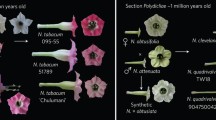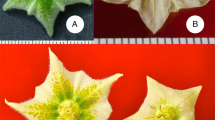Abstract
Main conclusion
Switches between pollination syndromes have happened frequently during angiosperm evolution. Using QTL mapping and reciprocal introgressions, we show that changes in reproductive organ morphology have a simple genetic basis.
In animal-pollinated plants, flowers have evolved to optimize pollination efficiency by different pollinator guilds and hence reproductive success. The two Petunia species, P. axillaris and P. exserta, display pollination syndromes adapted to moth or hummingbird pollination. For the floral traits color and scent, genetic loci of large phenotypic effect have been well documented. However, such large-effect loci may be typical for shifts in simple biochemical traits, whereas the evolution of morphological traits may involve multiple mutations of small phenotypic effect. Here, we performed a quantitative trait locus (QTL) analysis of floral morphology, followed by an in-depth study of pistil and stamen morphology and the introgression of individual QTL into reciprocal parental backgrounds. Two QTLs, on chromosomes II and V, are sufficient to explain the interspecific difference in pistil and stamen length. Since most of the difference in organ length is caused by differences in cell number, genes underlying these QTLs are likely to be involved in cell cycle regulation. Interestingly, conservation of the locus on chromosome II in a different P. axillaris subspecies suggests that the evolution of organ elongation was initiated on chromosome II in adaptation to different pollinators. We recently showed that QTLs for pistil and stamen length on chromosome II are tightly linked to QTLs for petal color and volatile emission. Linkage of multiple traits will enable major phenotypic change within a few generations in hybridizing populations. Thus, the genomic architecture of pollination syndromes in Petunia allows for rapid responses to changing pollinator availability.









Similar content being viewed by others
Abbreviations
- BLAST:
-
Basic local alignment search tool
- CAPS:
-
Cleaved amplified polymorphic sequence
- IL:
-
Introgression line
- LOD:
-
Logarithm of the odds
- PVE:
-
Phenotypic variation explained
- QTL:
-
Quantitative trait locus
References
Abràmoff MD, Magalhães PJ, Ram SJ (2004) Image processing with imageJ. Biophotonics Int 11:36–41
Barrett S (2010) Understanding plant reproductive diversity. Philos T Roy Soc B 365:99–109
Beavis WD (1994) The power to deceit of QTL experiments: lessons from comparative QTL studies. Proc Annu Corn and Sorghum Research Conference. American Seed Trade Association, Washington, D.C, pp 250–266
Berckmans B, De Veylder L (2009) Transcriptional control of the cell cycle. Curr Opin Plant Biol 12:599–605
Bernacchi D, Tanksley SD (1997) An interspecific backcross of Lycopersicon esculentum × L. hirsutum: linkage analysis and a QTL study of sexual compatibility factors and floral traits. Genetics 147:861–877
Bossolini E, Klahre U, Brandenburg A, Reinhardt D, Kuhlemeier C (2011) High resolution linkage maps of the model organism Petunia reveal substantial synteny decay with the related genome of tomato. Genome 54:327–340
Bradshaw HD, Schemske DW (2003) Allele substitution at a flower color locus produces a pollinator shift in monkeyflowers. Nature 426:176–178
Bradshaw HD, Wilbert SM, Otto KG, Schemske DW (1995) Genetic mapping of floral traits associated with reproductive isolation in monkeyflowers (Mimulus). Nature 376:762–765
Brothers AN, Barb JG, Ballerini ES, Drury DW, Knapp SJ, Arnold ML (2013) Genetic architecture of floral traits in Iris hexagona and Iris fulva. J Hered 104:853–861
Brown DE, Rashotte AM, Murphy AS, Normanly J, Tague BW, Peer WA, Taiz L, Muday GK (2001) Flavonoids act as negative regulators of auxin transport in vivo in Arabidopsis. Plant Physiol 126:524–535
Chen KY, Tanksley SD (2004) High-resolution mapping and functional analysis of se2.1: a major stigma exsertion quantitative trait locus associated with the evolution from allogamy to autogamy in the genus Lycopersicon. Genetics 168:1563–1573
Chen KY, Cong B, Wing R, Vrebalov J, Tanksley SD (2007) Changes in regulation of a transcription factor lead to autogamy in cultivated tomatoes. Science 318:643–645
Darvasi A, Soller M (1994) Optimum spacing and genetic markers for determining linkage between marker loci and quantitative trait loci. Theor Appl Genet 89:351–357
Dell’Olivo A, Kuhlemeier C (2013) Asymmetric effects of loss and gain of a floral trait on pollinator preference. Evolution 67:3023–3031
Doebley J (2004) The genetics of maize evolution. Annu Rev Genet 38:37–59
Fenster CB, Armbruster WS, Wilson P, Dudash MR, Thomson JD (2004) Pollination syndromes and floral specialization. Annu Rev Ecol Evol Syst 35:375–403
Fulton TM, Beck-Bunn T, Emmatty D, Eshed Y, Lopez J, Petiard V, Uhlig J, Zamir D, Tanksley SD (1997) QTL analysis of an advanced backcross of Lycopersicon peruvianum to the cultivated tomato and comparisons with QTLs found in other wild species. Theor Appl Genet 95:881–894
Gegear RJ, Burns JG (2007) The birds, the bees, and the virtual flowers: can pollinator behavior drive ecological speciation in flowering plants? Amer Nat 170:551–566
Gerats T, Strommer J (2009) Petunia: Evolutionary, developmental and physiological genetics, 2nd edn. Springer, New York
Hermann K, Klahre U, Moser M, Sheehan H, Mandel T, Kuhlemeier C (2013) Tight genetic linkage of prezygotic barrier loci creates a multifunctional speciation island in Petunia. Curr Biol 23:873–877
Hoballah ME, Gübitz T, Stuurman J, Broger L, Barone M, Mandel T, Dell’Olivo A, Arnold M, Kuhlemeier C (2007) Single gene-mediated shift in pollinator attraction in Petunia. Plant Cell 19:779–790
Hodges SA, Arnold ML (1994) Floral and ecological isolation between Aquilegia formosa and Aquilegia pubescens. Proc Natl Acad Sci USA 91:2493–2496
Hopkins R, Rausher MD (2011) Identification of two genes causing reinforcement in the Texas wildflower Phlox drummondii. Nature 469:411–414
Jacobs M, Rubery PH (1988) Naturally occurring auxin transport regulators. Science 241:346–349
Joehanes R, Nelson JC (2008) QGene 4.0, an extensible Java QTL-analysis platform. Bioinformatics 24:2788–2789
Kanazawa A, Inaba JI, Shimura H, Otagaki S, Tsukahara S, Matsuzawa A, Kim BM, Goto K, Masuta C (2011) Virus-mediated efficient induction of epigenetic modifications of endogenous genes with phenotypic changes in plants. Plant J 65:156–168
Kay KM, Schemske DW (2003) Pollinator assemblages and visitation rates for 11 species of neotropical Costus (Costaceae). Biotropica 35:198–207
Klahre U, Gurba A, Hermann K, Saxenhofer M, Bossolini E, Guerin PM, Kuhlemeier C (2011) Pollinator choice in Petunia depends on two major genetic loci for floral scent production. Curr Biol 21:730–739
Koes R, Souer E, Van Houwelingen A, Mur L, Spelt C, Quattrocchio F, Wing J, Oppedijk B, Ahmed S, Maes T, Gerats T, Hoogeveen P, Meesters M, Kloos D, Mol JNM (1995) Targeted gene inactivation in Petunia by PCR-based selection of transposon insertion mutants. Proc Natl Acad Sci USA 92:8149–8153
Komaki S, Sugimoto K (2012) Control of the plant cell cycle by developmental and environmental cues. Plant Cell Physiol 53:953–964
Li JY, Oulee TM, Raba R, Amundson RG, Last RL (1993) Arabidopsis flavonoid mutants are hypersensitive to UV-B radiation. Plant Cell 5:171–179
Lorenz-Lemke AP, Mäder G, Muschner VC, Stehmann JR, Bonatto SL, Salzano FM, Freitas LB (2006) Diversity and natural hybridization in a highly endemic species of Petunia (Solanaceae): a molecular and ecological analysis. Mol Ecol 15:4487–4497
Manly KF, Cudmore RH Jr, Meer JM (2001) Map Manager QTX, cross-platform software for genetic mapping. Mamm Genome 12:930–932
Martin A, Orgogozo V (2013) The loci of repeated evolution: a catalog of genetic hotspots of phenotypic variation. Evolution 67:1235–1250
Mo YY, Nagel C, Taylor LP (1992) Biochemical complementation of chalcone synthase mutants defines a role for flavonols in functional pollen. Proc Natl Acad Sci USA 89:7213–7217
Nakazato T, Rieseberg LH, Wood TE (2013) The genetic basis of speciation in the Giliopsis lineage of Ipomopsis (Polemoniaceae). Heredity 111:227–237
Napoli CA, Fahy D, Wang HY, Taylor LP (1999) white anther: a Petunia mutant that abolishes pollen flavonol accumulation, induces male sterility, and is complemented by a chalcone synthase transgene. Plant Physiol 120:615–622
Rockman MV (2012) The QTN program and the alleles that matter for evolution: all that’s gold does not glitter. Evolution 66:1–17
Segatto ALA, Cazé ALR, Turchetto C, Klahre U, Kuhlemeier C, Bonatto SL, Freitas LB (2014) Nuclear and plastid markers reveal the persistence of genetic identity: a new perspective on the evolutionary history of Petunia exserta. Mol Phylogenet Evol 70:504–512
Sheehan H, Hermann K, Kuhlemeier C (2013) Color and scent: how single genes influence pollinator attraction. Cold Spring Harb Symp Quant Biol 77:117–133
Shirley BW (1996) Flavonoid biosynthesis: ‘New’ functions for an ‘old’ pathway. Trends Plant Sci 1:377–382
Sicard A, Lenhard M (2011) The selfing syndrome: a model for studying the genetic and evolutionary basis of morphological adaptation in plants. Ann Bot 107:1433–1443
Sicard A, Stacey N, Hermann K, Dessoly J, Neuffer B, Bäurle I, Lenhard M (2011) Genetics, evolution and adaptive significance of the selfing syndrome in the genus Capsella. Plant Cell 23:3156–3171
Souer E, Quattrocchio F, de Vetten N, Mol J, Koes R (1995) A general method to isolate genes tagged by a high copy number transposable element. Plant J 7:677–685
Stehmann JR (1987) Petunia exserta (Solanaceae): Uma nova especio do Rio Grande do Sul, Brasil. Napaea Rev Bot 2:19–21
Stehmann JR, Lorenz-Lemke AP, Freitas L, Semir J (2009) The genus Petunia. In: Gerats T, Strommer J (eds) Petunia: evolutionary, developmental and physiological genetics, 2nd edn. Springer, New York, pp 1–28
Streisfeld MA, Rausher MD (2009) Altered trans-regulatory control of gene expression in multiple anthocyanin genes contributes to adaptive flower color evolution in Mimulus aurantiacus. Mol Biol Evol 26:433–444
Studer AJ, Doebley JF (2011) Do large effect QTL fractionate? A case study at the maize domestication QTL teosinte branched1. Genetics 188:673–681
Studer AJ, Doebley JF (2012) Evidence for a natural allelic series at the maize domestication locus teosinte branched1. Genetics 191:951–958
Stuurman J, Hoballah ME, Broger L, Moore J, Basten C, Kuhlemeier C (2004) Dissection of floral pollination syndromes in Petunia. Genetics 168:1585–1599
Thomson JD, Wilson P (2008) Explaining evolutionary shifts between bee and hummingbird pollination: convergence, divergence, and directionality. Int J Plant Sci 169:23–38
Truernit E, Bauby H, Dubreucq B, Grandjean O, Runions J, Barthélémy J, Palauqui JC (2008) High-resolution whole-mount imaging of three-dimensional tissue organization and gene expression enables the study of phloem development and structure in Arabidopsis. Plant Cell 20:1494–1503
Vandenbussche M, Janssen A, Zethof J, Van Orsouw N, Peters J, Van Eijk MJT, Rijpkema AS, Schneiders H, Santhanam P, De Been M, Van Tunen A, Gerats T (2008) Generation of a 3D indexed Petunia insertion database for reverse genetics. Plant J 54:1105–1114
Venail J, Dell’Olivo A, Kuhlemeier C (2010) Speciation genes in the genus Petunia. Philos T Roy Soc B 365:461–468
Wessinger CA, Hileman LC, Rausher MD (2014) Identification of major quantitative trait loci underlying floral pollination syndrome divergence in Penstemon. Philos T Roy Soc B. doi:10.1098/rstb.2013.0349
Yuan Y-W, Sagawa JM, Young R, Christensen BJ, Bradshaw HD Jr (2013) Genetic dissection of a major anthocyanin QTL contributing to pollinator-mediated reproductive isolation between sister species of Mimulus. Genetics 194:255–263
Acknowledgments
We thank T. Gerats, M. Lenhard, H. Summers and H. Sheehan for critical reading of the manuscript and insightful comments; R. Koes, F. Quattrocchio and R.J. Griesbach for plant materials; L. Freitas and A. Segatto for introducing us to Petunias in their native environment; C. Ball and N. Signer for taking care of the plants; M. Saxenhofer and M. Joest for their help with genotyping and phenotyping. This work was supported by grants from the National Centre for Competence in Research ‘Plant Survival’, the Swiss National Science Foundation and the University of Bern.
Conflict of interest
The authors declare that they have no conflict of interest.
Author information
Authors and Affiliations
Corresponding author
Electronic supplementary material
Below is the link to the electronic supplementary material.
Rights and permissions
About this article
Cite this article
Hermann, K., Klahre, U., Venail, J. et al. The genetics of reproductive organ morphology in two Petunia species with contrasting pollination syndromes. Planta 241, 1241–1254 (2015). https://doi.org/10.1007/s00425-015-2251-2
Received:
Accepted:
Published:
Issue Date:
DOI: https://doi.org/10.1007/s00425-015-2251-2




